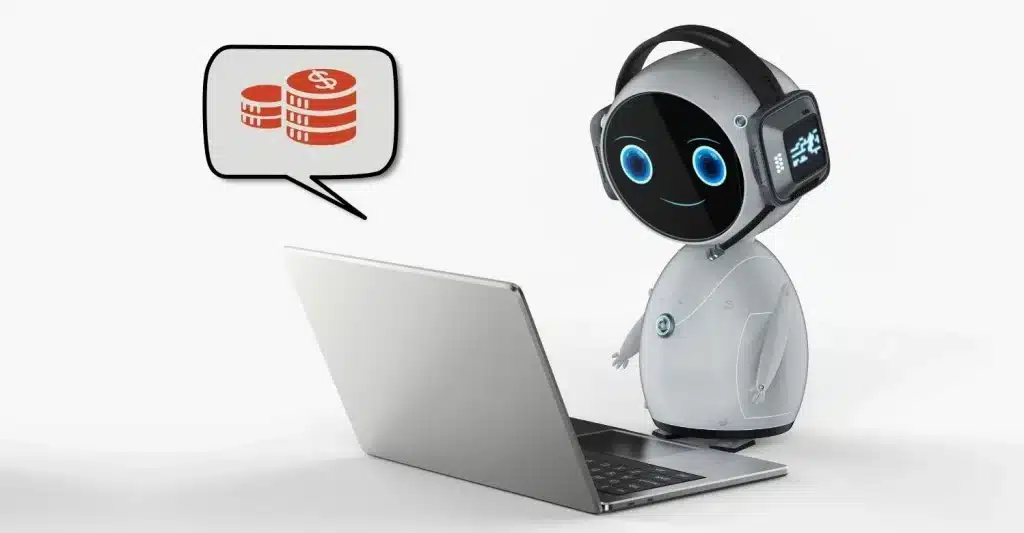Why calculating chatbots’ ROI? As investments in AI increase, so does the pressure to answer one blunt question: what’s the return on investment? It seems fair—after all, traditional tech investments must clear a hurdle rate. Why should AI be any different?
According to Deloitte’s State of Generative AI in the Enterprise, nearly three‑quarters (74 %) of organizations state their most advanced generative AI initiatives are meeting or exceeding ROI expectations, with around 20 % exceeding 30 % ROI. They also note that resolving challenges like governance, data quality, and talent typically takes 12+ months.
Updated on July 17th 2025
Estimated reading time: 5 minutes
Table of contents
Why calculating chatbots’ ROI?

Calculating a chatbot’s ROI cannot ignore the customer experience performance and KPIs such as average resolution time and chatbot responsiveness.
As with any project, before estimating the return on investment, it is necessary to identify the expected benefits and the costs of implementing a Conversational AI solution.
The benefits realized may include, for example:
- Savings on personnel costs, as the chatbot can automate many repetitive tasks
- Increased efficiency, as the chatbot can handle many requests simultaneously and provide immediate responses
- Optimization of agent workload and reduction of turnover
- Improved user experience, as the chatbot can provide personalized customer service available 24/7
- Data collection and analysis, as the chatbot can collect information on customer interactions and use it to improve products and services.
Costs incurred may include, for example:
- Chatbot development and implementation costs
- Chatbot maintenance and update costs
- Costs for integrating the chatbot with existing systems
- Costs for training staff on how to use the chatbot
However, while costs and benefits are necessary to calculate the chatbot’s ROI within a mathematical formula, implementing a conversational AI project requires, as always, starting from the customer journey and, therefore, a qualitative analysis of user requests.
First, it is necessary to identify and classify user requests by type:
What is the percentage of simple and redundant requests out of the total requests received? What is the number of complex requests that require the intervention of an operator?
In terms of user experience, what is the average time to handle a single request? That is, how long does the customer have to wait for a response to a question that falls within the simple handling categories?
Characteristics of a Good Chatbot
User experience primarily guides a company’s decisions regarding the implementation of a conversational AI project. Therefore, when calculating a chatbot’s ROI, the following characteristics must be considered:
These include:
- Artificial Intelligence: A good chatbot must be able to understand and respond meaningfully to user questions, using natural language processing (NLP), machine learning, and generative AI technologies.
- Scalability: A good virtual assistant can handle a large number of requests simultaneously, without compromising the quality of service.
- Personalization: A good chatbot can personalize responses based on information collected about the user and their interests.
- Ease of Use: A good chatbot must be easy for users to use, with an intuitive interface and fluid conversation.
- Management autonomy: The conversational AI platform for creating a chatbot must offer capabilities for autonomous management, integration, and monitoring of the solution.
- Data security: A good chatbot must ensure that user data is handled appropriately and in compliance with privacy regulations.
- Continuous improvement: A good chatbot must constantly evolve and improve to adapt to customer and business needs.
Chatbots’ ROI: Which Approach to Take

Working with rigid timelines and metrics can stifle strategic benefits.
Asking for ROI too early, too narrowly, and too literally, risks missing a broader and more complex business transformation.
Generative and agentic AI doesn’t just save money.
This technology can generate new work products, redesign professional roles, and operate autonomously. Its returns rarely come from a single cost or revenue stream.
Chatbot price, software, or “salaried”?
New licensing models defy comparisons with human labor costs. If you peg chatbot costs to today’s human wages, you risk overestimating when open-source or more efficient solutions are emerging.
Time is crucial.
Demanding a full return within 12 months is like asking for fruit from an orchard planted last season. It takes time to prepare data, drive adoption, and iterate improvements. It’s more useful to monitor early indicators such as model accuracy, process speed, and adoption rates.
Look beyond the single use case
The smartest companies don’t just use AI to automate a task: they deeply integrate it into core decision-making processes. True ROI emerges from the composite effect on the business model and company operations.
How to Calculate Chatbots’ ROI
What to keep in mind when calculating your chatbots’ ROI.
- Identify all costs
Initial setup: development, integration, licensing, training
O&M: hosting, updates, model tuning
Hidden costs: data cleaning, fallback agents, customer experience inefficiencies - Quantify the benefits
Operational time savings (e.g., X requests handled = Y hours saved)
Value of reduced human costs (e.g., replaced agents)
Benefits in terms of retention, CSAT, upsells, and loyalty - KPIs and indicators to monitor
Chatbot adoption rates
CSAT and NPS
Conclusions
The ROI of chatbots (or generative/agentic AI) shouldn’t be viewed in a rigid, short-term way. It requires time, data, culture, and a broader strategic vision. Organizations that structure projects with solid governance, train their staff, and deeply integrate AI into their processes often achieve results exceeding 100% ROI, which are sustainable over the long term.
Faqs about chatbots’ ROI
Typically between 6 and 12 months: it depends on scale, governance, data quality, and organizational support.
High data quality, strategic alignment, workforce readiness, deep integration with core processes, and AI decision-making endpoints.
Monetize the impact on CSAT, NPS, retention, and incremental sales as part of the total benefit.
Updated on July 17th 2025

